Analysis of Soil–Water Characteristic Curve and Microstructure of Undisturbed Loess
Abstract
:1. Introduction
2. Materials and Methods
2.1. Materials
2.2. SWCC Measurement
2.2.1. Test Apparatus
2.2.2. Experimental Process
2.3. PSD Measurement
2.4. SEM Tests
3. Results and Discussion
3.1. SWCCs of Undisturbed Loess Samples
3.1.1. SWCCs of the Undisturbed Loess Samples Buried in the Same Layer
3.1.2. SWCCs of Undisturbed Loess Samples Buried in Different Layers
3.2. Pore Structure and PSD Characteristics
3.3. Response of SWCCs to Pore Structure
4. Conclusions
- The soils buried at different depths exhibited similar grain compositions, with all loess samples showing bimodal particle size density distribution curves. This bimodal distribution indicates the presence of two hierarchical structures within the soil’s microstructure and macrostructure. A deeper burial resulted in a higher dry density, and the saturated volumetric water content of the undisturbed loess decreased by 10.9%, and the AEV increased from 13.67 to 40.19 kPa. Additionally, the suction range of the transition zone decreased, exhibiting different slopes.
- As the burial depth of the loess increased from 3.4 to 51.9 m, the SEM and MIP tests indicated a decrease in connectivity pores with an increasing depth, resulting in a decrease in ne from 50.69 to 38.88%: a total reduction of 11.81%. The PSD curves of all loess samples exhibit bimodal characteristics, corresponding to intra-aggregate pores within aggregates and inter-aggregate pores between aggregates, with a boundary at 150 nm. The intra-aggregate pores show little variation, while there are significant differences in the inter-aggregate pores. The content of macropores (d > 16,000 nm) decreased by 3.6%, the content of mesopores (4000 nm < d ≤ 16,000 nm) decreased by 12.1%, while the contents of small pores (1000 nm < d ≤ 4000 nm) and micropores (d ≤ 1000 nm) showed minor changes.
- It is crucial to emphasize that the SWCCs of undisturbed loess at various depths were predominantly controlled by the pore size distribution. Specifically, the total porosity controls the saturated volumetric water content of the SWCC. The number of dominant pores or the peak point of the PSD curve governed the SWCC desaturation mode. The inflection pore of the PSD curve along the mercury intrusion direction corresponded to the AEV of the SWCC. The range of dominant pores determined the transition zone of the SWCC, while the size of the dominant pores determined the slope of the transition zone curve. Furthermore, the micropores distribution determined the morphology of the residual zone of the SWCC. These findings underscore the pivotal role of the pore structure in governing the soil’s water retention behavior.
- Combining the macroscopic SWCC test results and microstructure characteristics of undisturbed loess samples buried at different depths, it can be concluded that the soil’s water retention behavior is strongly affected by the soil’s compaction effect. The larger the burial depth of the soil, the higher the dry density, which leads to a decrease in the total porosity of the soil, resulting in a decrease in the number of macropores and mesopores in the soil structure. This affects the morphological characteristics and model fitting parameters of the soil’s SWCC, resulting in differences in the water holding capacity of the soil. Therefore, when analyzing the propagation process of water in thick loess layers, it is necessary to fully consider the influence of the soil burial depth.
Author Contributions
Funding
Data Availability Statement
Conflicts of Interest
References
- Dijkstra, T.A.; Wasowski, J.; Winter, M.G.; Meng, X.M. Introduction to geohazards of Central China. Q. J. Eng. Geol. Hydrogeol. 2014, 47, 195–199. [Google Scholar] [CrossRef]
- Nan, J.J.; Peng, J.B.; Zhu, F.J.; Ma, P.H.; Liu, R.; Leng, Y.Q.; Meng, Z.J. Shear behavior and microstructural variation in loess from the Yan’an area, China. Eng. Geol. 2021, 280, 105964. [Google Scholar] [CrossRef]
- Gao, L.; Shao, M. The interpolation accuracy for seven soil properties at various sampling scales on the Loess Plateau, China. J. Soils Sediments 2012, 12, 128–142. [Google Scholar] [CrossRef]
- Yao, X.; Fu, B.; Lü, Y.; Chang, R.; Wang, S.; Wang, Y.; Su, C.H. The multi-scale spatial variance of soil moisture in the semi-arid Loess Plateau of China. J. Soils Sediments 2012, 12, 694–703. [Google Scholar] [CrossRef]
- Peng, J.B.; Tong, X.; Wang, S.K.; Ma, P.H. Three-dimensional geological structures and sliding factors and modes of loess landslides. Environ. Earth Sci. 2018, 77, 675. [Google Scholar] [CrossRef]
- Huang, T.M.; Ma, B.; Pang, Z.; Li, Z.; Li, Z.; Long, Y. How does precipitation recharge groundwater in loess aquifers? Evidence from multiple environmental tracers. J. Hydrol. 2020, 583, 124532. [Google Scholar] [CrossRef]
- Hou, X.; Li, T.; Vanapalli, S.K.; Xi, Y. Water percolation in a thick unsaturated loess layer considering the ground-atmosphere interaction. Hydrol. Process. 2019, 33, 794–802. [Google Scholar] [CrossRef]
- Wang, C.X.; Li, T.L.; Li, P.; Wang, Y.; Li, H.; Xi, Y. Verification on the mode of moisture transfer in the vadose zone of thick loess. Hydrol. Process. 2022, 36, e14656. [Google Scholar] [CrossRef]
- Li, P.; Li, T.L.; Vanapalli, S.K. Influence of environmental factors on the wetting front depth: A case study in the Loess Plateau. Eng. Geol. 2016, 214, 1–10. [Google Scholar] [CrossRef]
- Zhang, C.L.; Li, T.L.; Li, P. Rainfall infiltration in Chinese loess by in situ observation. J. Hydrol. Eng. 2014, 19, 06014002. [Google Scholar] [CrossRef]
- Hou, X.; Qi, S.; Liu, F. Soil Water Retention and Pore Characteristics of Intact Loess Buried at Different Depths. Sustainability 2023, 15, 14890. [Google Scholar] [CrossRef]
- Li, X.A.; Li, L.C.; Song, Y.X.; Hong, B.; Wang, L.; Sun, J.Q. Characterization of the mechanisms underlying loess collapsibility for land-creation project in Shaanxi Province, China-a study from a micro perspective. Eng. Geol. 2019, 249, 77–88. [Google Scholar] [CrossRef]
- Fredlund, D.G.; Xing, A.; Fredlund, M.D.; Barbour, S.L. The relationship of the unsaturated soil shear strength to the soil-water characteristic curve. Can. Geotech. J. 1996, 33, 440–448. Available online: https://cdnsciencepub.com/doi/10.1139/t96-065 (accessed on 11 April 2024). [CrossRef]
- Chaney, R.C.; Demars, K.R.; Öberg, A.L.; Sällfors, G. Determination of Shear Strength Parameters of Unsaturated Silts and Sands Based on the Water Retention Curve. Geotech. Test. J. 1997, 20, 40–48. [Google Scholar] [CrossRef]
- Huang, S.Y.; Barbour, S.L.; Fredlund, D.G. Development and verification of a coefficient of permeability function for a deformable unsaturated soil. Can. Geotech. J. 1998, 35, 411–425. [Google Scholar] [CrossRef]
- Lim, P.C.; Barbour, S.L.; Fredlund, D.G. The influence of degree of saturation on the coefficient of aqueous diffusion. Can. Geotech. J. 1998, 35, 811–827. [Google Scholar] [CrossRef]
- Vanapalli, S.K.; Fredlund, D.G.; Pufahl, D.E.; Clifton, A.W. Model for the prediction of shear strength with respect to soil suction. Can. Geotech. J. 1996, 33, 379–392. [Google Scholar] [CrossRef]
- Vanapalli, S.K.; Fredlund, D.G.; Pufahl, D.E. The influence of soil structure and stress history on the soil-water characteristics of a compacted till. Géotechnique 1999, 51, 573–576. [Google Scholar] [CrossRef]
- Fredlund, D.G. Unsaturated soil mechanics in engineering practice. J. Geotech. Geoenviron. 2006, 132, 286–321. [Google Scholar] [CrossRef]
- Lu, N.; Likos, W.J. Suction stress characteristic curve for unsaturated soil. J. Geotech. Geoenviron. 2006, 132, 131–142. [Google Scholar] [CrossRef]
- Wen, B.P.; Yan, Y.J. Influence of structure on shear characteristics of the unsaturated loess in Lanzhou, China. Eng. Geol. 2014, 168, 46–58. [Google Scholar] [CrossRef]
- Ng, C.W.; Sadeghi, H.; Jafarzadeh, F. Compression and shear strength characteristics of compacted loess at high suctions. Can. Geotech. J. 2017, 54, 690–699. [Google Scholar] [CrossRef]
- Tu, H.Y.; Vanapalli, S.K. Prediction of the variation of swelling pressure and one-dimensional heave of expansive soils with respect to suction using the soil-water retention curve as a tool. Can. Geotech. J. 2016, 53, 1213–1234. [Google Scholar] [CrossRef]
- Gao, Q.F.; Zeng, L.; Shi, Z.N. Effects of desiccation cracks and vegetation on the shallow stability of a red clay cut slope under rainfall infiltration. Comput. Geotech. 2021, 140, 104436. [Google Scholar] [CrossRef]
- Gao, Y.; Li, Z.; Sun, D.A.; Yu, H.H. A simple method for predicting the hydraulic properties of unsaturated soils with different void ratios. Soil Tillage Res. 2021, 209, 104913. [Google Scholar] [CrossRef]
- Liu, Y.; Tian, G.; Wang, S.; Satyanaga, A.; Zhai, Q. Parametric Analysis of Rainfall-Induced Loess Soil Slope Due to the Rainwater Infiltration. Urban Sci. 2022, 6, 54. [Google Scholar] [CrossRef]
- Lu, N.; Likos, W.J. Unsaturated Soil Mechanics; John Wiley: Hoboken, NJ, USA, 2004. [Google Scholar]
- Yang, H.; Rahardjo, H.; Leong, E.C.; Fredlund, D.G. Factors affecting drying and wetting soil-water characteristic curves of sandy soils. Can. Geotech. J. 2004, 41, 908–920. [Google Scholar] [CrossRef]
- Simms, P.H.; Yanful, E.K. Predicting soil-water characteristic curves of compacted plastic soils from measured pore-size distributions. Géotechnique 2002, 52, 69–278. [Google Scholar] [CrossRef]
- Wang, Y.; Li, T.L.; Zhao, C.X.; Hou, X.K.; Li, P.; Zhang, Y. A study on the effect of pore and particle distributions on the soil water characteristic curve of compacted loess soil. Environ. Earth Sci. 2021, 80, 764. [Google Scholar] [CrossRef]
- Gao, Y.; Sun, D.A. Soil-water retention behavior of compacted soil with different densities over a wide suction range and its prediction. Comput. Geotech. 2017, 91, 17–26. [Google Scholar] [CrossRef]
- Hu, R.; Chen, Y.F.; Liu, H.H.; Zhou, C.B. A water retention curve and unsaturated hydraulic conductivity model for deformable soils: Consideration of the change in pore-size distribution. Geotechnique 2013, 63, 1389–1405. [Google Scholar] [CrossRef]
- Beckett, C.T.S.; Augarde, C.E. Prediction of soil water retention properties using pore-size distribution and porosity. Can. Geotech. J. 2013, 50, 435–450. [Google Scholar] [CrossRef]
- Jabro, J.D.; Stevens, W.B. Pore Size Distribution Derived from Soil–Water Retention Characteristic Curve as Affected by Tillage Intensity. Water 2022, 14, 3517. [Google Scholar] [CrossRef]
- Ng, C.W.W.; Sadeghi, H.; Hossen, S.B.; Chiu, C.F.; Alonso, E.E.; Baghbanrezvan, S. Water retention and volumetric characteristics of intact and re-compacted loess. Can. Geotech. J. 2016, 53, 1258–1269. [Google Scholar] [CrossRef]
- Li, P.; Li, T.L.; Vanapalli, S.K. Prediction of soil-water characteristic curve for Malan loess in Loess Plateau of China. J. Cent. South Univ. 2018, 25, 432–447. [Google Scholar] [CrossRef]
- Mu, Q.Y.; Dong, H.; Liao, H.J.; Dang, Y.J.; Zhou, C. Water-retention curves of loess under wettingdrying cycles. Geotech. Lett. 2020, 10, 135–140. [Google Scholar] [CrossRef]
- Chen, X.; Ma, M.; Zhou, S.; Hu, M.; Ma, J.; Wei, S. Determining the Bimodal Soil-Water Characteristic Curve of Fine-Grained Subgrade Soil Derived from the Compaction Condition by Incorporating Pore Size Distribution. Processes 2023, 11, 3394. [Google Scholar] [CrossRef]
- Jiang, M.J.; Li, T.; Hu, H.J.; Thornton, C. DEM analyses of one-dimensional compression and collapse behaviour of unsaturated structural loess. Comput. Geotech. 2014, 60, 47–60. [Google Scholar] [CrossRef]
- Li, P.; Xie, W.L.; Pak, R.Y.S.; Vanapalli, S.K. Microstructural evolution of loess soils from the Loess Plateau of China. Catena 2019, 173, 276–288. [Google Scholar] [CrossRef]
- Hou, X. Prediction of the Soil–Water Retention Curve of Loess Using the Pore Data from the Mercury Intrusion Technique. Water 2023, 15, 3273. [Google Scholar] [CrossRef]
- Li, X.A.; Li, N.C. Quantification of the pore structures of Malan loess and the effects on loess permeability and environmental significance, Shaanxi Province, China: An experimental study. Environ. Earth Sci. 2017, 76, 523. [Google Scholar] [CrossRef]
- Sasanian, S.; Newson, T.A. Use of mercury intrusion porosimetry for microstructural investigation of reconstituted clays at high water contents. Eng. Geol. 2013, 158, 15–22. [Google Scholar] [CrossRef]
- Wang, J.D.; Li, P.; Ma, Y.; Vanapalli, S.K. Evolution of pore-size distribution of intact loess and remolded loess due to consolidation. J. Soils Sediments 2018, 19, 1226–1238. [Google Scholar] [CrossRef]
- Wang, H.M.; Ni, W.K.; Yuan, K.Z.; Nie, Y.P.; Li, L. Study on SWCC and PSD evolution of compacted loess before and after drying-wetting cycles. Bull. Eng. Geol. Environ. 2023, 82, 180. [Google Scholar] [CrossRef]
- Muñoz-Castelblanco, J.A.; Pereira, J.M.; Delage, P.; Cui, Y.J. The water retention properties of natural unsaturated loess from northern France. Géotechnique 2012, 62, 95. [Google Scholar] [CrossRef]
- Satyanaga, A.; Rahardjo, H.; Leong, E.; Wang, J.Y. Water characteristic curve of soil with bimodal grain-size distribution. Comput. Geotech. 2013, 48, 51–61. [Google Scholar] [CrossRef]
- Schindler, U.; Müller, L. Simplifying the evaporation method for quantifying soil hydraulic properties. J. Plant Nutr. Soil Sc. 2006, 169, 623–629. [Google Scholar] [CrossRef]
- Peters, A.; Durner, W. Simplified evaporation method for determining soil hydraulic properties. J. Hydrol. 2008, 356, 147–162. [Google Scholar] [CrossRef]
- Juang, C.H.; Holtz, R.D. Fabric, Pore Size Distribution, and Permeability of Sandy Soils. J. Geotech. Eng. 1986, 112, 855–868. [Google Scholar] [CrossRef]
- Romero, E.; Gens, A.; Lloret, A. Water permeability, water retention and microstructure of unsaturated compacted Boom clay. Eng. Geol. 1999, 54, 117–127. [Google Scholar] [CrossRef]
- Jiang, M.J.; Zhang, F.G.; Hu, H.J.; Cui, Y.J.; Peng, J.B. Structural characterization of natural loess and remolded loess under triaxial tests. Eng. Geol. 2014, 181, 249–260. [Google Scholar] [CrossRef]
- Li, P.; Shao, S.J.; Vanapalli, S.K. Characterizing and modeling the pore-size distribution evolution of a compacted loess during consolidation and shearing. J. Soils Sediments 2020, 20, 2855–2867. [Google Scholar] [CrossRef]
- Xiao, T.; Li, P.; Shao, S.J. Fractal dimension and its variation of intact and compacted loess. Powder Technol. 2022, 395, 476–490. [Google Scholar] [CrossRef]
- Van Genuchten, M.T. A closed-form equation for predicting the hydraulic conductivity of unsaturated soils. Soil Sci. Soc. Am. J. 1980, 44, 892–898. [Google Scholar] [CrossRef]
- Fredlund, D.G.; Xing, A. Erratum: Equations for the soil-water characteristic curve. Can. Geotech. J. 1994, 31, 521–532. [Google Scholar] [CrossRef]
- Brooks, R.H.; Corey, A.T. Hydraulic Properties of Porous Media and Their Relation to Drainage Design. Trans. ASAE 1964, 7, 26–28. [Google Scholar] [CrossRef]
- Sillers, W.S.; Fredlund, D.G.; Zakerzadeh, N. Mathematical attributes of some soil-water characteristic curve models. Geotech. Geol. Eng. 2001, 19, 243–283. [Google Scholar] [CrossRef]
- Marinho, F.A.M. Nature of Soil-Water Characteristic Curve for Plastic Soils. J. Geotech. Geoenviron. 2005, 131, 654–661. [Google Scholar] [CrossRef]
- Kadir, K.; Askin, O.Z.; Tuncer, B.E.; Ertan, B.; Sedat, S.; Kurban, O.; Mustafa, O. Evaluation of Soil-Water Characteristic Curve and Pore-Size Distribution of Fine-Grained Soils. Water 2022, 14, 3445. [Google Scholar] [CrossRef]
- Shen, J.H.; Hu, M.J.; Wang, X.; Zhang, C.Y.; Xu, D.S. SWCC of calcareous silty sand under different fines contents and dry densities. Front. Environ. Sci. 2021, 9, 682907. [Google Scholar] [CrossRef]
- Wang, J.D.; Li, P.; Ma, Y.; Vanapalli, S.K.; Wang, X.G. Change in pore-size distribution of collapsible loess due to loading and inundating. Acta Geotech. 2019, 15, 1081–1094. [Google Scholar] [CrossRef]
- Li, P.; Vanapalli, S.; Li, T.L. Review of collapse triggering mechanism of collapsible soils due to wetting. J. Rock Mech. Geotech. 2016, 8, 256–274. [Google Scholar] [CrossRef]
- Xiao, T.; Li, P.; Pan, Z.H.; Hou, Y.F.; Wang, J.D. Relationship between water retention capacity and pore-size distribution of compacted loess. J. Soils Sediments 2022, 22, 3151–3165. [Google Scholar] [CrossRef]
- Lei, X.Y. The types of loess pores in china and their relationship with collapsibility. Sci. China Ser. B 1988, 31, 1398–1411. [Google Scholar] [CrossRef]
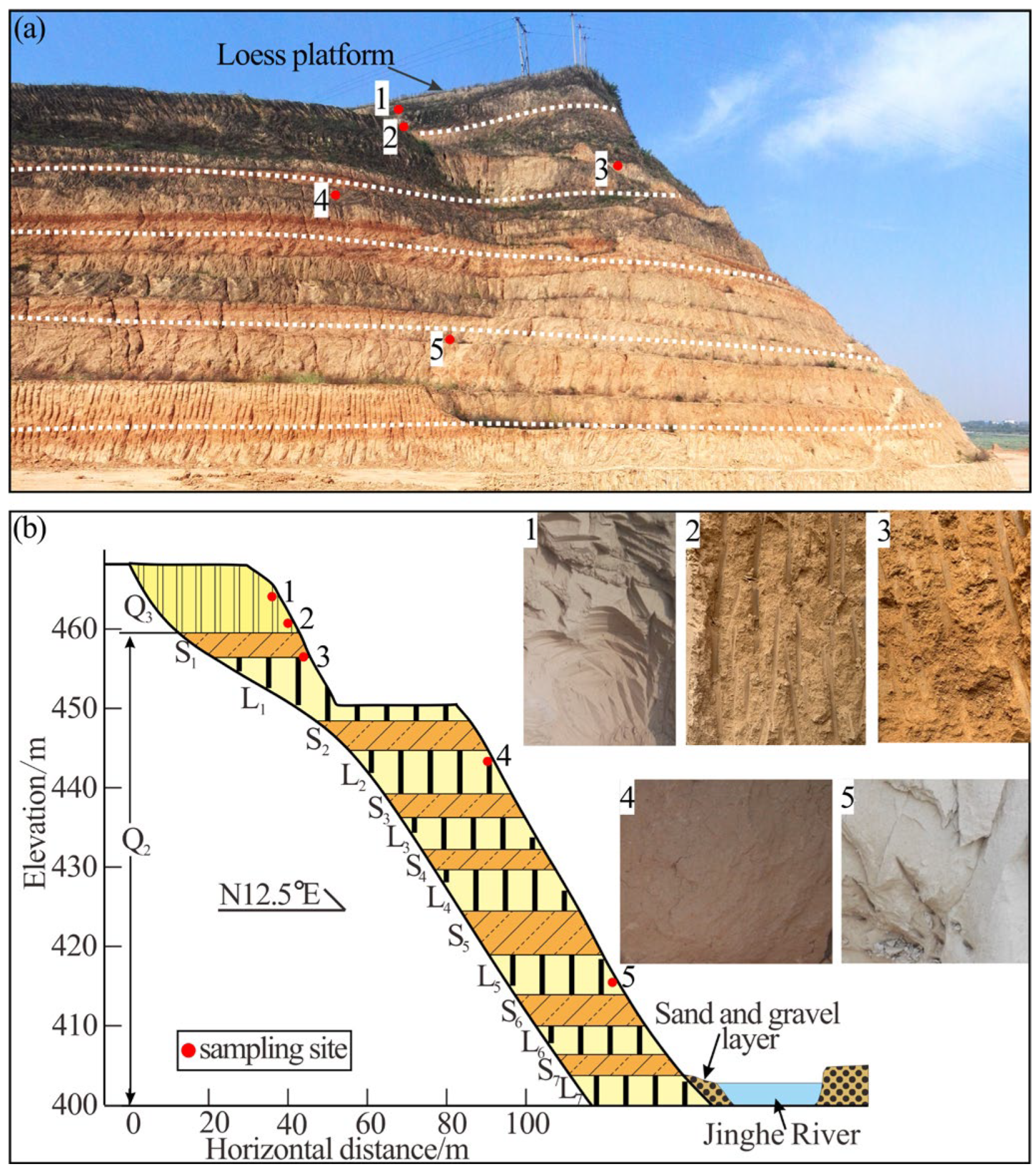

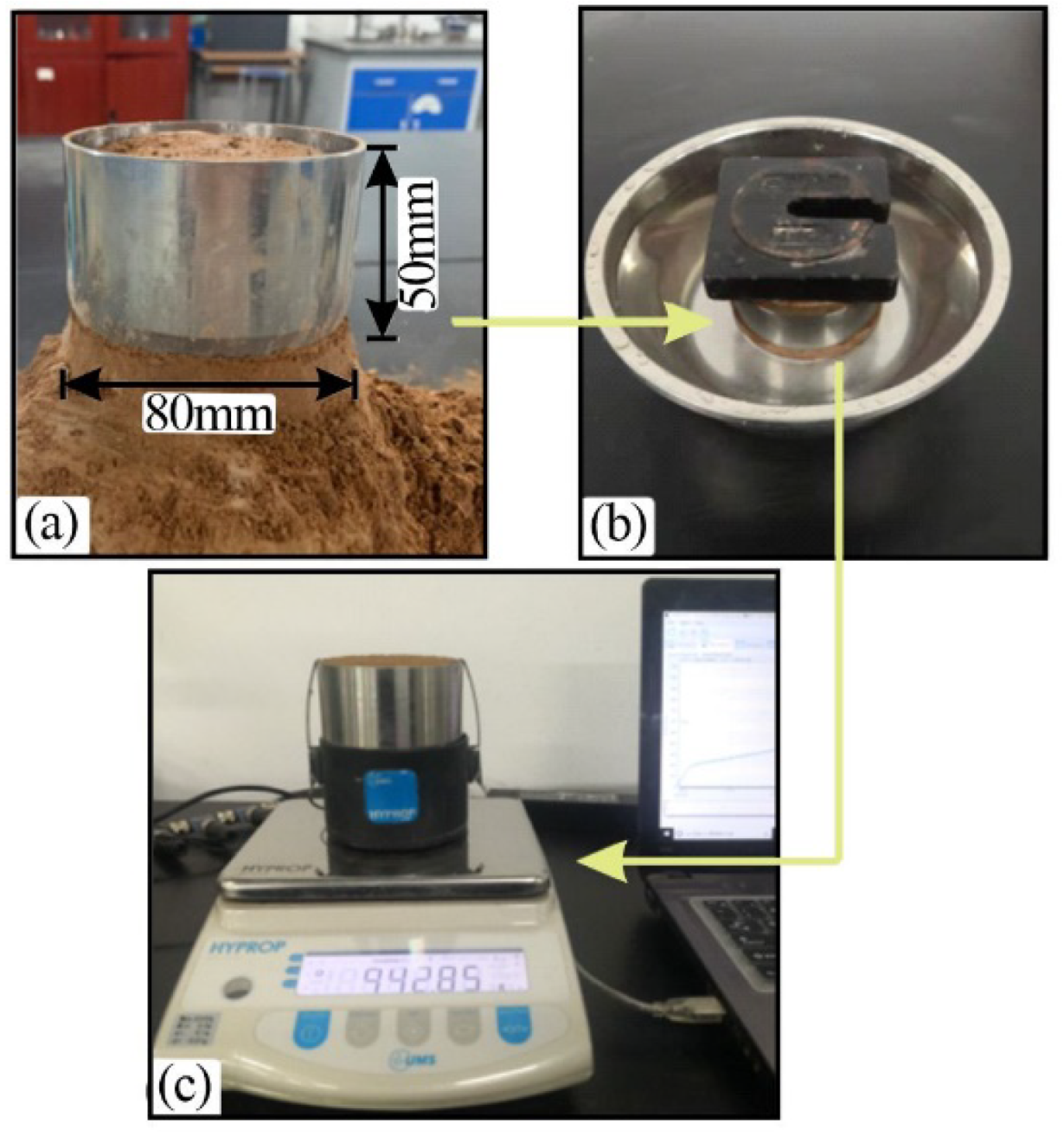


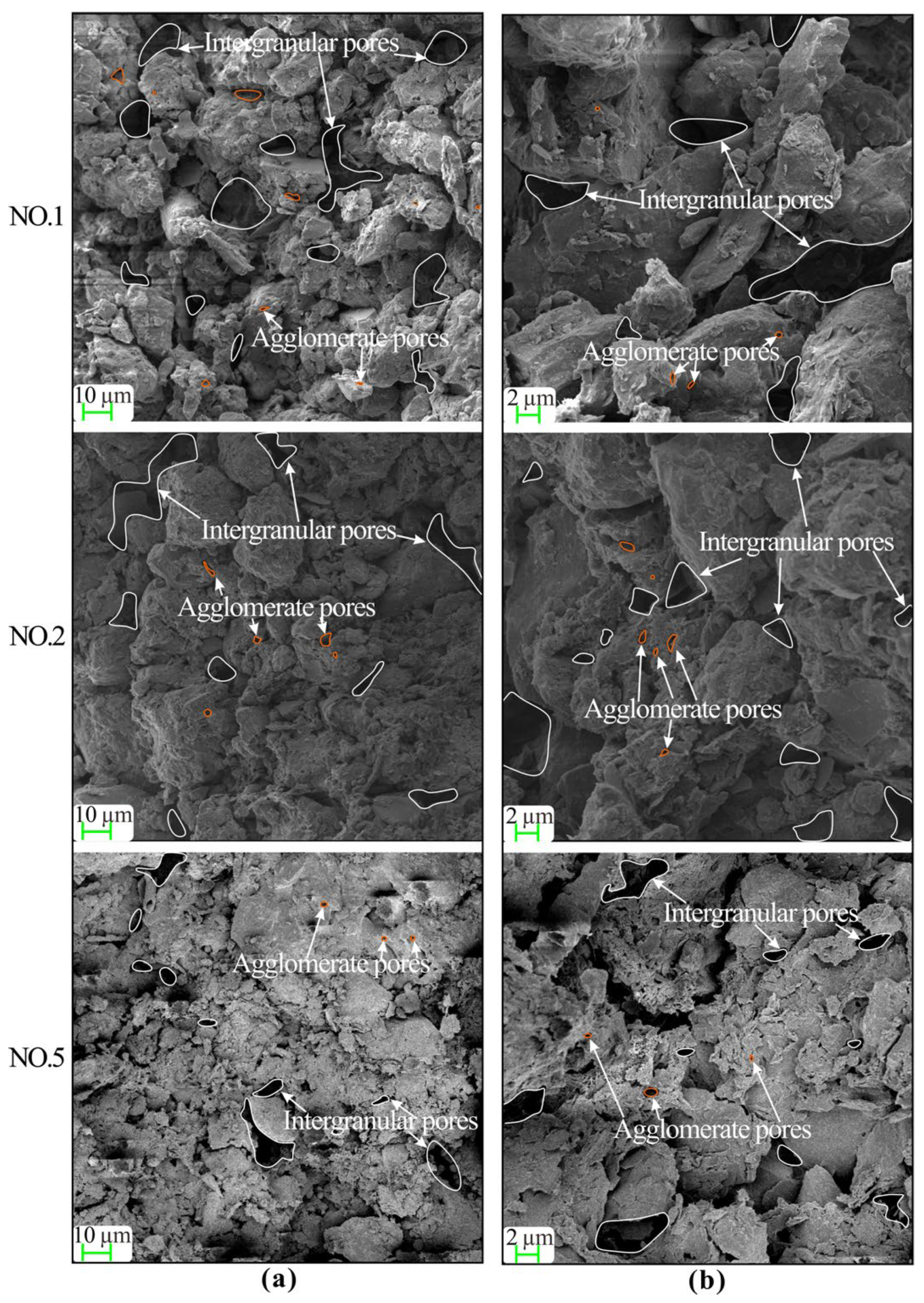
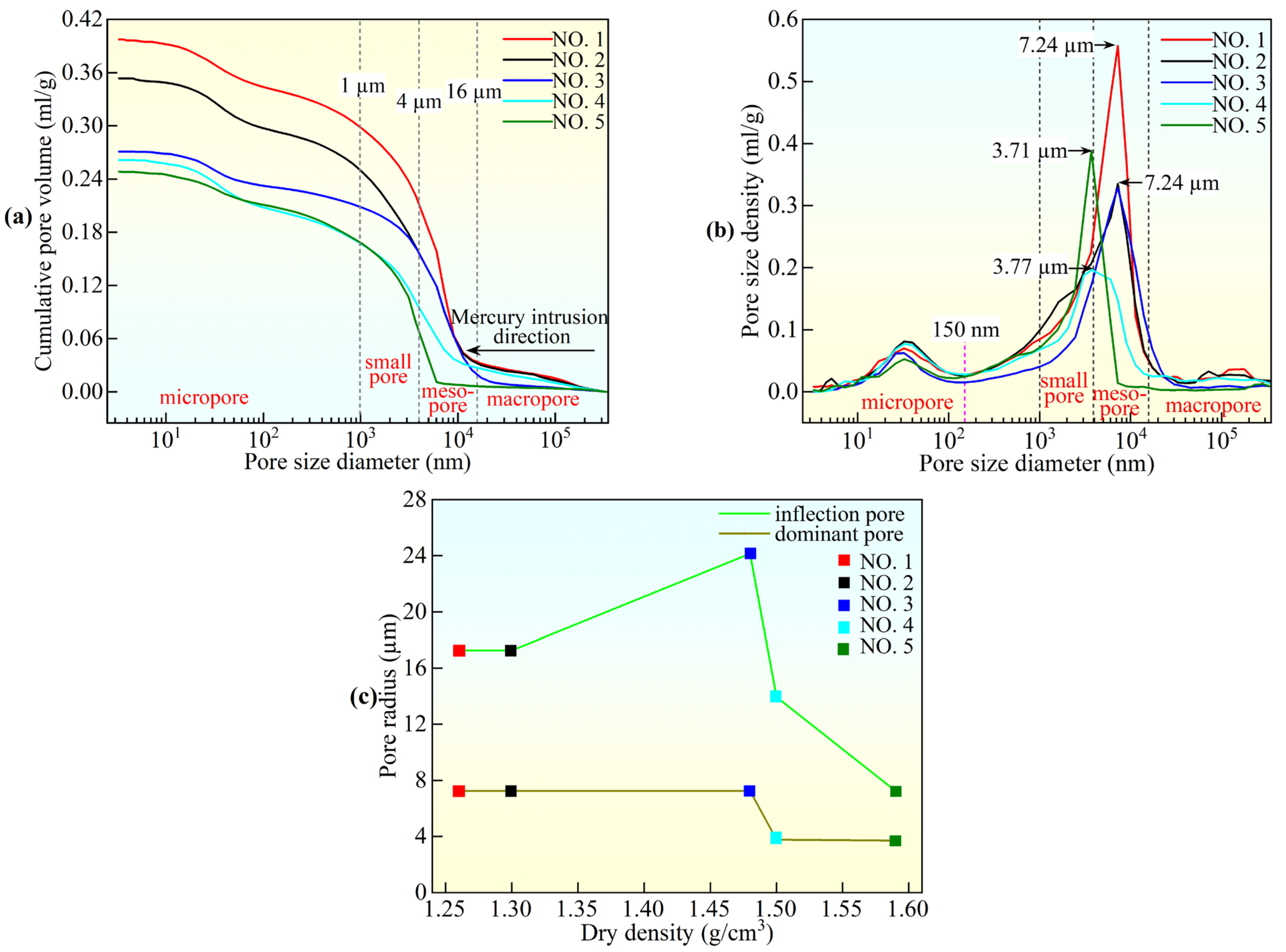

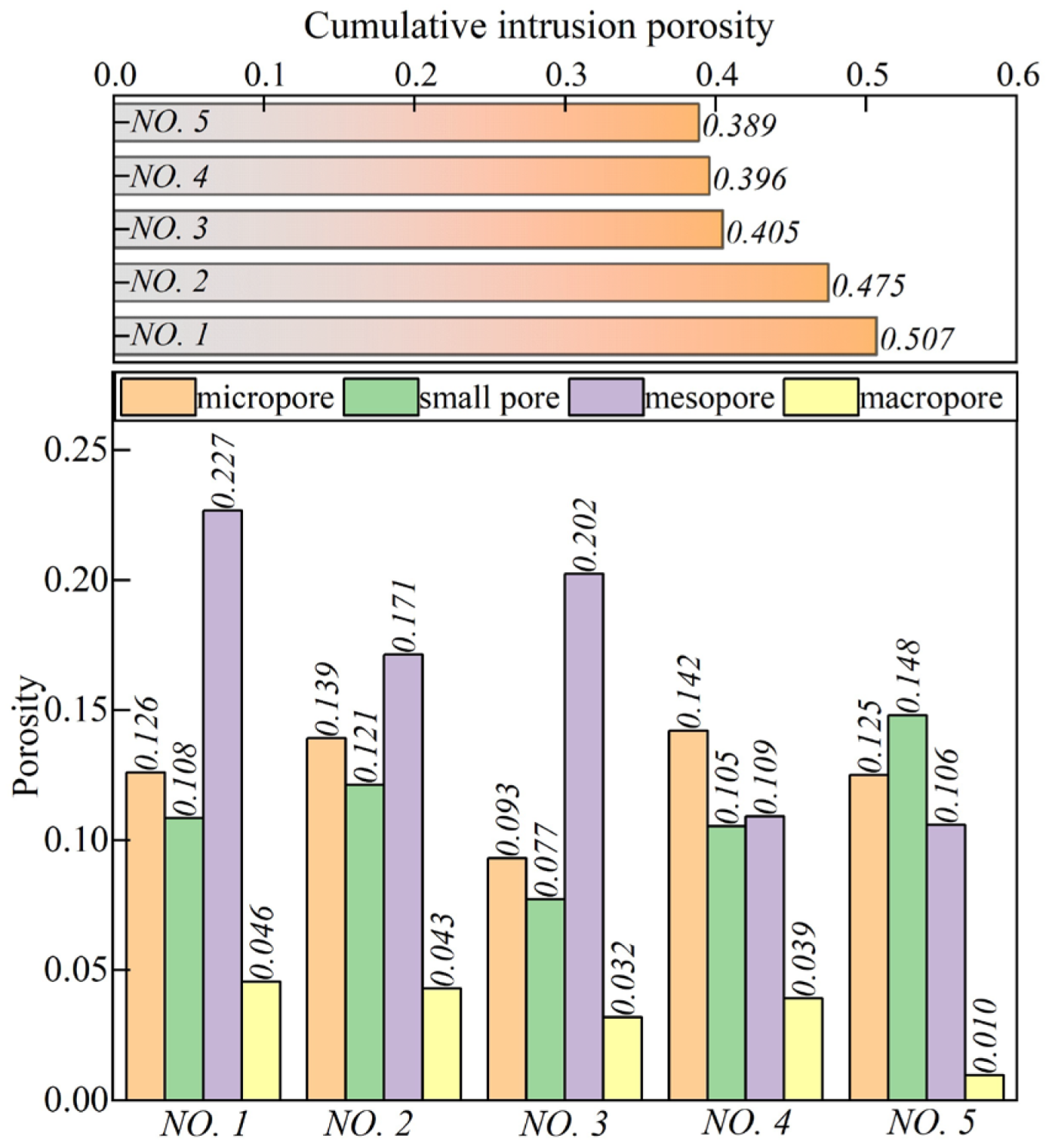
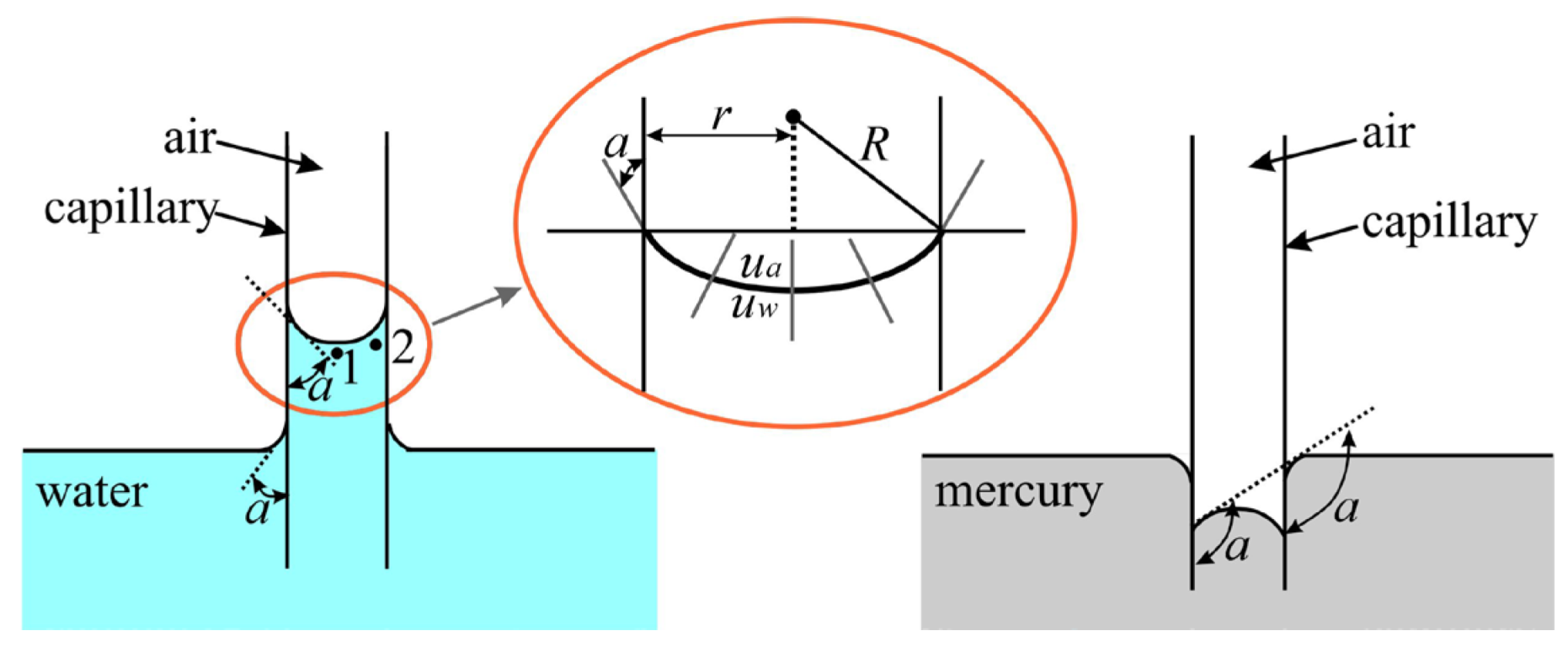
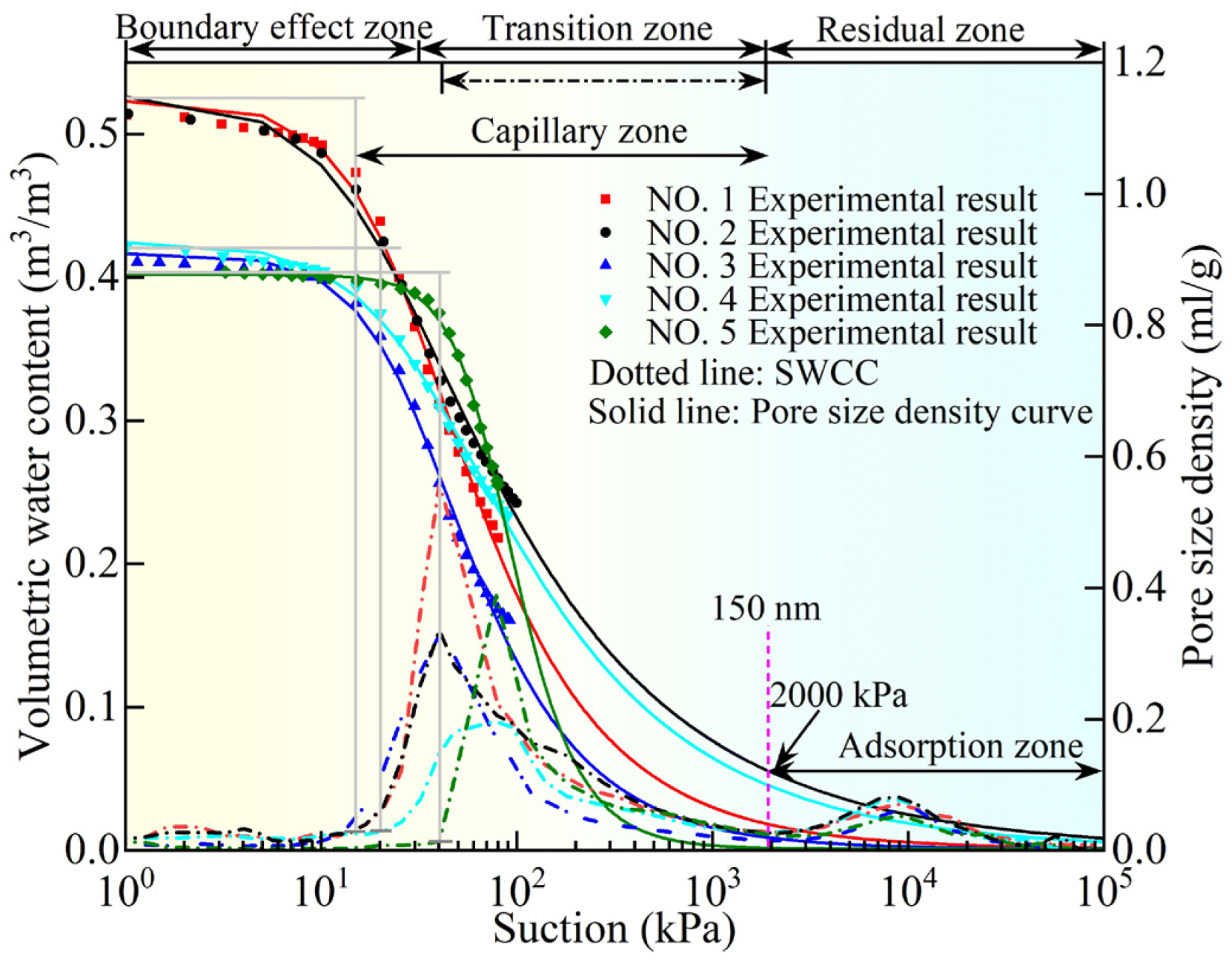
| Sample | NO. 1 | NO. 2 | NO. 3 | NO. 4 | NO. 5 |
|---|---|---|---|---|---|
| Depth (m) | 3.4 | 8.5 | 13.2 | 25 | 51.9 |
| In situ water content (%) | 8.10 | 18.08 | 10.17 | 10.00 | 10.00 |
| Dry density (g/cm3) | 1.27 | 1.30 | 1.50 | 1.51 | 1.59 |
| Initial void ratio, e | 1.11 | 1.10 | 0.81 | 0.79 | 0.71 |
| Specific gravity, Gs | 2.70 | 2.70 | 2.71 | 2.71 | 2.71 |
| Liquid limit, wL (%) | 32.48 | 32.90 | 33.00 | 30.05 | 29.92 |
| Plastic limit, wP (%) | 19.24 | 17.60 | 16.60 | 16.99 | 18.09 |
| Plasticity index, IP (%) | 13.24 | 15.30 | 16.40 | 13.06 | 11.83 |
| Clay (0–0.002 mm) (%) | 2.58 | 4.56 | 2.26 | 3.71 | 2.69 |
| Silt (0.002–0.075 mm) (%) | 65.37 | 83.94 | 54.93 | 69.51 | 73.32 |
| Sand (0.075–2 mm) (%) | 32.05 | 11.50 | 42.81 | 26.78 | 23.99 |
| Effective particle diameter (µm) | 6.42 | 3.98 | 7.66 | 4.96 | 5.33 |
| Median diameter (µm) | 19.00 | 11.91 | 28.87 | 16.34 | 17.80 |
| Control particle size (µm) | 50.50 | 28.86 | 88.12 | 42.32 | 40.95 |
| Coefficient of uniformity, Cu | 7.87 | 7.24 | 11.50 | 8.53 | 7.68 |
| Coefficient of curvature, Cc | 1.11 | 1.23 | 1.23 | 1.27 | 1.45 |
| Sample | R2 | ||||
|---|---|---|---|---|---|
| NO. 1 | 0.523 | 0.001 | 0.037 | 1.801 | 0.994 |
| NO. 2 | 0.528 | 0.001 | 0.049 | 1.498 | 0.993 |
| NO. 3 | 0.412 | 0.001 | 0.030 | 2.017 | 0.997 |
| NO. 4 | 0.425 | 0.001 | 0.031 | 1.552 | 0.996 |
| NO. 5 | 0.404 | 0.001 | 0.015 | 2.541 | 0.996 |
| Sample | Sample Burial Depth (m) | Dry Density ρd (g/cm3) | Porosityn (%) | Effective Porosity ne (%) | Mercury Intrusion Efficiency φ (%) |
|---|---|---|---|---|---|
| NO. 1 | 3.4 | 1.27 | 53.33 | 50.69 | 95.04 |
| NO. 2 | 8.5 | 1.30 | 52.21 | 47.50 | 90.99 |
| NO. 3 | 13.2 | 1.50 | 44.65 | 40.47 | 90.64 |
| NO. 4 | 25 | 1.48 | 44.28 | 39.59 | 89.41 |
| NO. 5 | 51.9 | 1.59 | 41.33 | 38.88 | 94.08 |
Disclaimer/Publisher’s Note: The statements, opinions and data contained in all publications are solely those of the individual author(s) and contributor(s) and not of MDPI and/or the editor(s). MDPI and/or the editor(s) disclaim responsibility for any injury to people or property resulting from any ideas, methods, instructions or products referred to in the content. |
© 2024 by the authors. Licensee MDPI, Basel, Switzerland. This article is an open access article distributed under the terms and conditions of the Creative Commons Attribution (CC BY) license (https://creativecommons.org/licenses/by/4.0/).
Share and Cite
Tan, Y.; Dai, F.; Zhao, Z.; Zhou, J.; Cheng, W. Analysis of Soil–Water Characteristic Curve and Microstructure of Undisturbed Loess. Appl. Sci. 2024, 14, 3329. https://doi.org/10.3390/app14083329
Tan Y, Dai F, Zhao Z, Zhou J, Cheng W. Analysis of Soil–Water Characteristic Curve and Microstructure of Undisturbed Loess. Applied Sciences. 2024; 14(8):3329. https://doi.org/10.3390/app14083329
Chicago/Turabian StyleTan, Ye, Fuchu Dai, Zhiqiang Zhao, Jian Zhou, and Wei Cheng. 2024. "Analysis of Soil–Water Characteristic Curve and Microstructure of Undisturbed Loess" Applied Sciences 14, no. 8: 3329. https://doi.org/10.3390/app14083329





